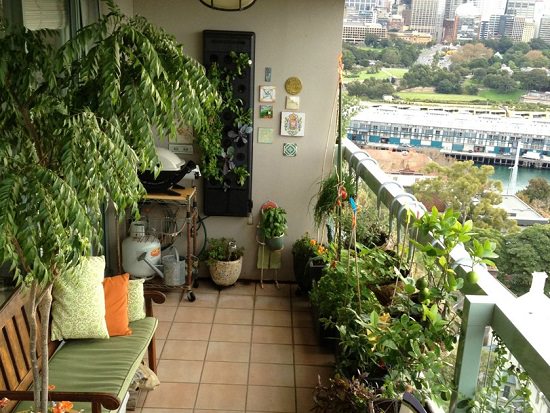If you live in a downtown area, or on a high floor, your balcony may be pretty windy. In urban areas, wind is funneled in between buildings and can really rip through balconies and the plants growing there. Wind poses several problems to vegetable container gardens. First, it can damage the plant by ripping off leaves, or breaking branches. It can also tear off flowers before they can be pollinated. No pollination, no fruit/vegetables. Wind can also be cold, a bad thing if you’re trying to grow warm season vegetables like tomatoes or eggplant. Finally, wind dries plants and soil out.
Rest assured, there are things you can do to counteract the effects of wind on your container vegetable garden…
Protecting from Wind Damage
There are a couple of options for protecting plants from being whipped around in the wind. You can try one or the other, or use them in conjunction with each other for the best results. The first thing to try is to create a windbreak. Anything solid that you can put in between your vegetable garden and the direction the wind comes from will help. For example, you can purchase pieces of clear plexiglass and drill holes in the corners so that you can use zip ties to affix the plexiglass to your balcony railings. Of course this will only block the wind that comes through the railings. You can also use plants as windbreaks. Use a planter box to plant a dense hedge along the edge of your balcony.
The second thing to try will help protect young seedlings. Wrap clear plastic around the outside of a sturdy tomato cage. Poke a few small holes in the plastic to allow for air flow. Allowing some air to get through will help prevent diseases from taking hold and will also help strengthen the stems of the plant without breaking them.
Keeping Soil Moist
If you have lots of wind blowing through your container garden, it is really important that you go the extra mile to keep your potting soil from drying out. Wind will dry out the leaves of your plant, causing it to try and draw up more water from the soil. If you leave the soil uncovered, wind will also dry out the soil, compounding the problem.
If you need something super cheap, copy what EarthBox does and use a piece of black plastic (try cutting up a trash bag) to cover the surface of your pot. Use white plastic if you live in the desert. Fill the pot all the way to the rim with soil, and mix in slow release fertilizer. Secure the plastic over the soil with a large rubberband so that the plastic is taut. Use a sharp knife to cut an ‘X’ in the middle of the plastic that is just large enough to dig a hole and plant your seedling.
If the plastic mulch look doesn’t suit your tastes, use an inch of gravel, marbles, or tumbled glass to cover the soil after you’ve planted the seedling. If this is the route you choose, be sure to only fill the pot with soil to two inches below the lip of the pot so that you’ll have room for the gravel. Don’t use wood chips, they’ll just blow away and make a mess.
Beating the Cold
If your area gets chilly winds, wait to put out your warm season vegetables for as long as possible. For example, tomato plants will not grow very well (or at all) in temperatures below 60 degrees. Eggplants can be even more sensitive to cold weather. You can also look for varieties of vegetables bred for their cold hardiness. For tomatoes, that often means a tomato with the word “early” in it’s name, or a name that connotes cold temperature, like “polar” or “arctic.” These varieties produce fruit in a relatively short period of time, allowing you to put them out when things have warmed up, and still have time to produce fruit before fall.




